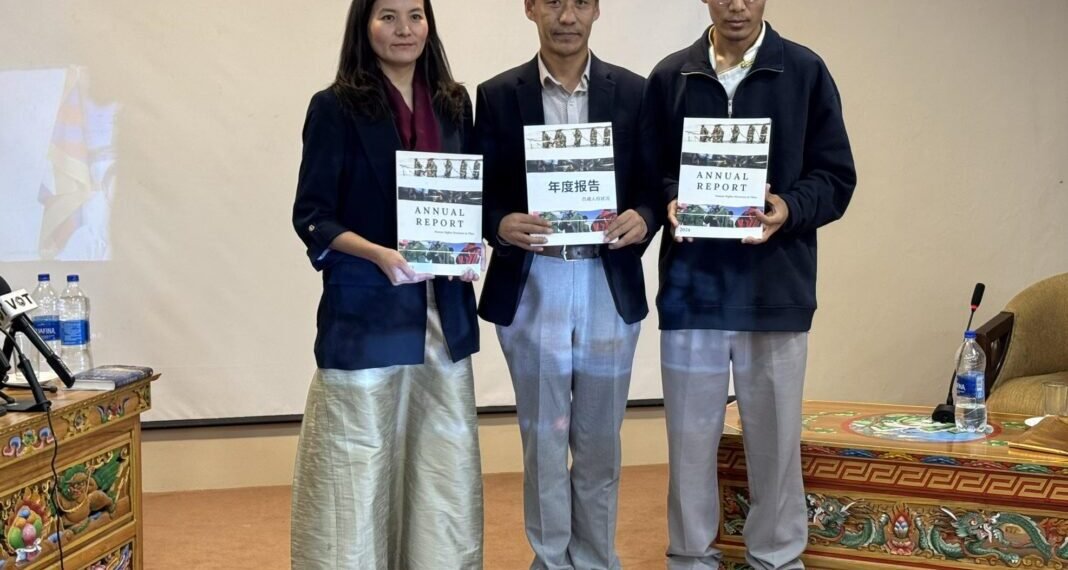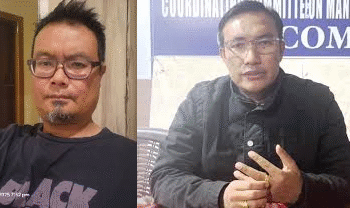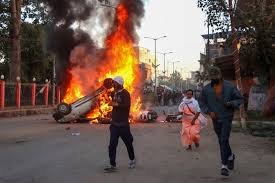The TCHRD has released a damning report, “If Gyalmo Ngulchu Could Feel: Crimes Against Humanity in Driru,” alleging widespread human rights abuses by Chinese authorities between 2012 and 2022. The report details a brutal crackdown following Tibetan protests against flag-flying campaigns and calls for international accountability.
BY Navin Upadhyay
April 4, 2025
In a damning indictment of Beijing’s rule over Tibet, the Tibetan Centre for Human Rights and Democracy (TCHRD) today released a comprehensive and deeply disturbing report, asserting that the region is not the harmonious “paradise” portrayed by Chinese authorities but rather a “hell” characterized by systematic oppression and egregious human rights violations.
The twin release of the TCHRD’s “2024 Annual Report on the Human Rights Situation in Tibet” and a focused, meticulously documented account titled “If Gyalmo Ngulchu Could Feel: Crimes Against Humanity in Driru” paints a grim picture of a decade of brutality, particularly within Driru County, located in the traditionally Tibetan Kham region, now controversially incorporated by China into the Tibetan Autonomous Region (TAR).
The findings were presented at a press conference and panel discussion held at Norbu House in Mcleod Ganj, Dharamshala, the seat of the Tibetan government-in-exile. The panel comprised leading voices in the Tibetan human rights movement, including Tsering Tsomo, the incisive Director of Research at the TCHRD, who provided an overview of the reports’ key findings; Kunchok Rinchen, a legal expert who navigated the complexities of documenting abuses under a tightly controlled regime; Tenzin Kalden, an independent researcher offering historical context and analysis; Lobsang Tendar, the articulate Vice-President of the Regional Tibetan Youth Congress (RTYC) France, who emphasized the global implications of the findings; and Tenzin Thinley, a dedicated researcher at the TCHRD, who expertly moderated the discussion, guiding the audience through the gravity of the revelations.
འདས་ལོར་བོད་ནང་གི་འགྲོ་བ་མིའི་ཐོབ་ཐང་གི་གནས་སྟངས་ཇེ་ཞན་ཇེ་སྡུག་ཏུ་ཕྱིན་པ་མ་ཟད་འབྲི་རུ་ནང་དམྱལ་བ་ལྟ་བུའི་གནས་སྟངས་ཡོད་པ་མངོན་གསལ།
TCHRD Releases Annual Report, Calls for Investigation into Acts of Crimes against Humanity in Driru#tchrd #reporthttps://t.co/mTYBORgxSa— Voice Of Tibet (@VOT_Tibetan) April 4, 2025
Tsering Tsomo directly confronted the narrative presented in a recent Chinese white paper, which lauded the supposed happiness and stability of Tibetans within the TAR. “But in reality, this is a far cry from the truth,” Tsomo declared with conviction. “Our report on Driru, a county firmly within the TAR’s boundaries, provides irrefutable evidence of the relentless oppression, the arbitrary detentions, the systematic torture, and the tragic killings that Tibetans have endured and continue to face at the hands of Chinese authorities in this region.”
ALSO READ: Mystery Around Tibetan Lama’s Death as China Withholds Body
She pointed to the staggering alleged events of 2013, where a reported 1,300 Tibetans in Driru were subjected to arrest, torture, and death within a mere three months, unequivocally denouncing these actions as “crimes against humanity” under international law. Tsomo underscored the TCHRD’s solemn responsibility to unmask the true human rights catastrophe unfolding in Driru, a microcosm of the broader situation across Tibet.
Tenzin Kalden delved into the deep-rooted history of Tibetan resistance in Driru, tracing the community’s defiance back to the initial Chinese invasion of 1958. He highlighted the courageous participation of Driru residents in the Chushi Gangdruk, the formidable Tibetan guerrilla force that valiantly fought against the People’s Liberation Army following the 1959 Lhasa Uprising. Kalden recounted deeply disturbing testimonies of extreme brutality, including a chilling account of 46 Tibetans allegedly being shot dead in front of their families in a single location, with the surviving family members then forced to dance in a macabre display orchestrated by the Chinese military. These historical accounts served to underscore the long and tragic history of repression in the region.
ALSO READ: Manipur: MHA to Hold Key Talks Between Kuki-Zo-Hmar and Meitei Leaders Tomorrow
Lobsang Tendar of RTYC France broadened the scope of the discussion, arguing that the documented atrocities in Driru are not isolated aberrations but rather symptomatic of a pervasive pattern of human rights abuses that extends across all three traditional provinces of Tibet: U-Tsang, Kham, and Amdo. He emphasized that countless Tibetans have suffered death, arbitrary arrest, brutal torture, and lengthy imprisonment simply for peacefully expressing dissent against the Chinese Communist Party’s (CCP) restrictive and often culturally destructive policies in Tibet. Tendar passionately appealed to the Central Tibetan Administration, the Tibetan Parliament-in-Exile, and the global network of Tibetan activists and freedom fighters to leverage the meticulously researched findings of the Driru report as irrefutable evidence of the Chinese government’s inhumane treatment of the Tibetan people when engaging with the international community and advocating for the restoration of Tibetan freedoms.
Kunchok Rinchen, a key figure in the report’s compilation, illuminated the immense obstacles faced in gathering accurate information from Driru County, a region subject to intense surveillance and information control by Chinese authorities over the four-year research period. He powerfully reiterated the stark contrast between China’s carefully constructed narrative of stability and prosperity in the TAR and the grim reality on the ground.
“While Beijing speaks of a Tibetan paradise, Driru is, in truth, a living hell,” Rinchen declared. He cited credible, albeit difficult to fully verify, accounts of mass arrests in Driru, including one particularly alarming report suggesting that as many as 600 Tibetans were incarcerated within a single cell at the notorious Drapchi Prison, widely recognized as Tibet’s largest and most oppressive detention facility. Rinchen also shared deeply personal accounts of loss, recounting the killings of close friends’ fathers by Chinese police, underscoring the profound human cost of the repression. He concluded with a fervent call for the Tibetan government-in-exile and international Tibetan organizations to initiate legal proceedings against the Chinese government at international forums, seeking justice for the “crimes against humanity” perpetrated against Tibetans, particularly in the ravaged Driru County.
Following the poignant panel discussion, the TCHRD formally launched the 89-page report, aptly titled “If Gyalmo Ngulchu could feel: Crimes against humanity in Driru.” This meticulously researched document provides a granular account of the widespread and systematic human rights violations allegedly committed by Chinese authorities within Driru County over the decade spanning 2012 to 2022.
The report meticulously presents extensive evidence, including firsthand testimonies and credible secondary sources, to support its conclusion that these abuses – encompassing persecution based on political and religious grounds, arbitrary and incommunicado detention, the routine use of torture and other cruel, inhuman, or degrading treatment, and credible allegations of extrajudicial killings – constitute egregious crimes against humanity. The TCHRD argues that these actions are not isolated incidents but rather form part of a deliberate, state-directed policy aimed at systematically suppressing any manifestation of Tibetan resistance to Chinese rule and forcibly eroding Tibetan national and cultural identity.
ALSO READ: Pressure on China Grows Over Tibet’s Human Rights Violations
A central focus of the report is the detailed examination of the violent crackdown that erupted in Driru following the symbolic act of defiance on September 28, 2013. On that day, local Tibetans, demonstrating their unwavering opposition to a coercive flag-flying campaign orchestrated by Chinese authorities, bravely dumped numerous five-starred Chinese national flags into the turbulent waters of the Gyalmo Ngulchu (known as the Nujiang or Salween River in Chinese). This campaign, which sought to supplant the deeply revered Tibetan prayer flags traditionally flown on rooftops with Chinese national symbols under threat of punitive measures such as the denial of essential social services, was perceived by Tibetans as a profound assault on their cultural and religious heritage. The peaceful act of protest was met with a brutal and disproportionate response from Chinese security forces, triggering a wave of mass arbitrary arrests, widespread incidents of torture and ill-treatment in detention, and the deployment of deadly force against unarmed civilians, effectively plunging the entire Driru region into a state of intense security lockdown.
The report provides a harrowing account of the events of October 6, 2013, when Chinese security forces reportedly opened fire on a large group of unarmed Tibetan protesters in Driru, resulting in grievous injuries to at least 60 individuals, with four reportedly sustaining life-threatening wounds. This act of state-sanctioned violence was followed by a sustained campaign of repression, characterized by mass arrests, the imposition of draconian restrictions on freedom of movement and communication within the region, and the implementation of long-term punitive measures targeting Tibetans suspected of any form of dissent.
The report poignantly details how Tibetans living in exile remain effectively severed from any meaningful contact with their families residing in Driru, with those within Tibet facing the constant threat of imprisonment and further persecution if they are found to have communicated with relatives abroad.
Beyond the immediate acts of violence and repression, the TCHRD report meticulously documents the long-term socio-economic and cultural devastation wrought by Chinese policies in Driru. These include the systematic forced separation of families as a tool of control, the implementation of an omnipresent mass surveillance apparatus leading to widespread psychological trauma and the fragmentation of social cohesion within communities, the deliberate suppression of Tibetan language education in favor of Mandarin Chinese, thereby undermining the preservation of Tibetan cultural heritage, and the implementation of discriminatory economic policies, including severe restrictions on the traditional harvesting of the highly prized yartsa gunbu (cordyceps fungus), a critical source of livelihood for many families in the region.
Despite the overwhelming body of evidence meticulously compiled in the report, the TCHRD laments the fact that the Chinese government has consistently refused to conduct any independent or impartial investigation into the serious allegations of human rights abuses in Driru County. While China’s decision not to become a signatory to the Rome Statute, the treaty establishing the International Criminal Court (ICC), presents a significant obstacle to direct ICC intervention, the TCHRD strongly emphasizes that the international community possesses a range of other diplomatic, political, and legal avenues to exert pressure on China and hold individual perpetrators of these alleged crimes accountable for their actions.
In its powerful concluding statement, the Tibetan Centre for Human Rights and Democracy unequivocally asserts that “the findings in this report make it abundantly clear that the situation in Driru constitutes a grave and ongoing human rights crisis that demands the immediate and sustained attention of the international community. The relentless persecution and systematic repression of the Tibetan people in Driru, and indeed across Tibet, must no longer be ignored by the world.” The report serves as a stark reminder of the urgent need for concerted international action to address the human rights catastrophe unfolding in Tibet and to ensure that those responsible for these alleged atrocities are ultimately held to account.













